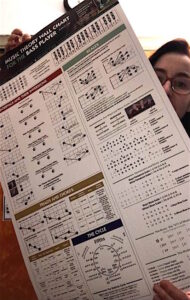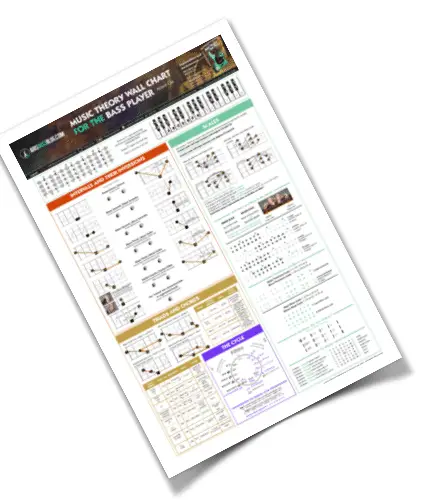 The Wall Chart is ready!
The Wall Chart is ready!
Currently Offering Free Domestic Shipping (Save $5.00)!
Please allow up to five weeks for delivery.
International shipping available.
International customers: postage will be computed for your country at check out. 5 posters ship for the same price as one. Share with a buddy to save on rates!
Wall Wisdom at 17 by 28 inches
for $24.95
An 18 by 27 inch visual reminder of important music theory basics!
Enrich your practice room!
Music theory needs hands-on practicing just like everything else. Just knowing and understanding it “in theory” is not enough. Having shapes under your fingers to use them in a musical situation effectively is where it’s at. To help keep the most important points to remember fresh in your mind, hang this comprehensive and clever wall chart in your practice room: it arranges the most important building blocks of music in a visually appealing and easy-to-grasp chart, with reference to the fretboard.
The Music Theory for the Bass Player Wall Chart is…
- a stand-alone resource for everyone familiar with the basics of music theory
- a great add-on to the book to serve as a visual reminder and summary
- a 17 by 28 inches sized high quality offset printed poster
- created to be visually appealing, inspiring and informative through the use of fretboard diagrams, photos and examples
- professionally designed by a team of designers led by the author with input from students and readers of Ariane’s book
 It contains, in logical presentation:
It contains, in logical presentation:
- How notes are organized in a piano as well as fretboard diagram to aide visual memorization
- Intervals and their inversions with fretboard diagrams, best fingering examples and tips for identifying them by ear
- A whole new way to think about intervals: Ari’s Interval Formula
- Triads with fretboard diagrams and best fingering practices
- explanations of how triads and sevenths chords are built, correctly named and how they sound
- Scales:
- major and natural minor scales: how to best think about their construction for improvising and grooving
- relative and parallel scale relationships
- pentatonic and blues scales, both major and minor
- an easy to memorize blueprint for the blues
- the modes (of the major scale): their sounds and shortcuts for creating them
- The Cycle of Fifths as well as the Diatonic Cycle of Fifths and how to construct them
